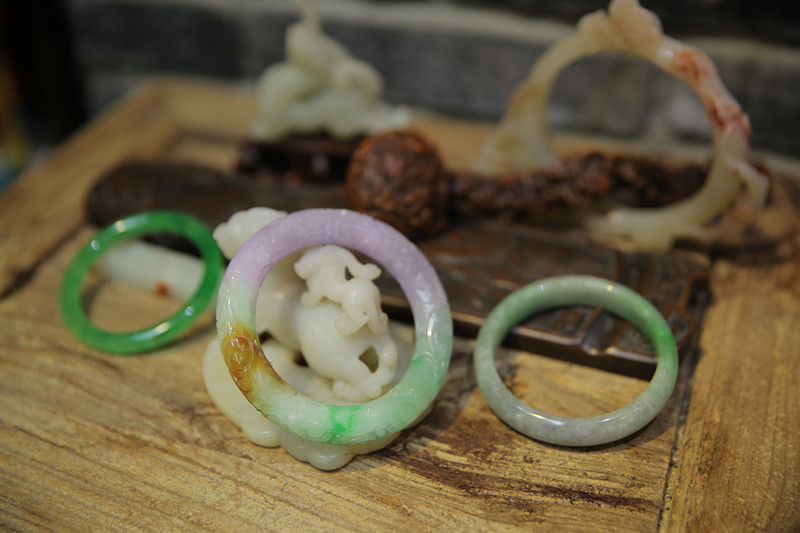中国文化学上的玉,内涵宽广,并不只是其在矿物学上的意义。汉代许慎在《说文解字》中说,玉,石之美兼五德者。所谓五德,即指玉的五个特性。凡具有坚韧的质地,晶润的光泽,绚丽的色彩,致密而透明的组织,舒扬致远的声音的美石,都被认为是玉。中国古玉不但历史悠久,而且影响深远,玉和中国民族的历史、政治、文化和艺术的产生和发展存在着密切关系,它影响着中华民族世世代代人们的观念和习俗,影响着中国历史上各朝各代的典章制度,影响着一大批文学、历史著作。

中国是世界上重要的产玉国,不仅开采历史悠久,而且分布地域极广,蕴藏量较大。据《山海经》记载,中国产玉地点有200多处。最著名的玉石是新疆和田玉,它和河南独山玉、辽宁的岫岩玉和湖北的绿松石,合称为中国的四大玉石。
中国玉文化的历史分别是:上游的神玉时期,中游的王玉时期和下游的民玉时期。

神玉时期是指在史前文化期的四千多年这段历史。在生产力极其低下的原始社会里,先民们认识自然,适应自然的能力极弱,对自然界各种现象无法解释并充满恐惧,认为宇宙万物皆有神灵存在。而集宗教、神权于一身的部落酋长们,又极需借助一种实物载体来作为与神灵沟通的媒介,从而展示自己的威严,实现统治。于是就找到了凝聚天地山川、日月精华的玉器。此时的玉器是一种图腾崇拜。史前社会对动物的崇拜是一种普遍现象,如北方燕山以北,大凌河与西辽河流域红山文化的“玉猪龙”。这种猪首蛇身,首尾相接,弯成圆形的玉器,便是最具代表性的。红山先民把变形了的猪类动物作为神灵来供奉。一些专家认为“玉猪龙”是龙的雏形,中华民族对龙图腾的崇拜或许源于此。此时的玉器还是祭祀天地的一种神器。如太湖流域良渚文化的玉琮。觋巫在祭祀作法时,以苍璧礼天,执玉琮与天地沟通,传达神的旨意。玉器被赋予了神秘的宗教色彩,部落的力量因此被聚集,增强了适应自然的能力,推动了史前社会的发展。
王玉时期是指从夏王朝开始至唐末的近三千年这段历史。夏是我国原始社会解体后成立的第一个国。其沿袭了酋长制的一些统治手段,玉器的作用被沿用并赋予了新的意义。从此开始,玉器走下神坛,充当王权的工具。河南偃师二里头夏朝遗址出土的玉圭等代表权力等级的玉器证明,夏开创王权玉器之先河。周代规范了玉器等级森严的礼仪制度。“以玉作六瑞,以等拜国。王执镇圭,公执恒圭,侯执信圭,伯执躬圭,子执谷璧,男执蒲璧。”每逢朝觐,从天子到诸侯,各执不同玉器,以示地位身份。汉承周礼。唐代礼制略有改变,其以玉腰带来区分官职大小。玉腰带只有皇帝、亲王和三品以上官员才能系带,从七片到十三片不等,片数越多等级越高。最能代表王权的玉器莫过于从秦代开始,上篆“受命于天,既寿永昌”的传国玉玺。玉玺代表天命,没有天命是不能当皇帝的,此后二千多年,历代皇朝为争夺和寻找此玉玺,发生了许多血雨腥风和光怪陆离的传奇故事。
民玉时期是指宋代以后的历史。此时用玉出现“双轨制”。帝王宗法用玉依然故我,民间生活用玉闪亮登场。“旧时王谢堂前燕,飞入寻常百姓家”。玉器终于摆脱皇室贵族的独家垄断,大量融入民间。坊间出现了玉铺,推动了琢玉业的兴旺,玉器作为一种特殊商品进入流通市场,成为士庶百姓喜庆、佩戴、日用和收藏的重要器物。
民间玉器宋代以文玩著名。明代越加世俗,各种佩饰、缀饰、串饰等小件玉器成为主流。清代以玉为饰更是普遍,还出现大量与金、银、竹、木等材质结合的玉嵌件。明清两代小玉器洋洋洒洒流传至今。
中国玉器源远流长,已有7000年的辉煌历史。愿本馆的玉器在展现其自身价值的同时可以让观者同时感受博大的中华文化。
Tianyi Jade Wares Museum
Jade in Chinese culture is meaningful and not limited to the mineralogy. In 說文解字 (shuo wen jie zi), the first Chinese dictionary published in 200 CE, jade was defined as "beautiful stones with 5 De, or virtues, represented in jade " by Xu Zhen. 5 De indicate five characteristics of jade, including extreme hardness, its polish and brilliancy, Its color, the pure and prolonged sound, its perfect compactness and transparency. Jade has been a part of Chinese civilization from the beginning, and possesses a close relationship with the existence and development of Chinese history, politics, culture and arts, influencing Chinese thoughts and customs, rules and institutions in different dynasties as well as literary and historical works profoundly.
China is a significant jade nation with a long history of mining jade which is widely spread in China with rich reserves. According to Shan Hai Jing(Classic of Mountains and Seas), there are over 200 jade mining sites in China. Four famous Chinese jade contains Khotan jade(nephrite) in Xinjiang Uyghur Autonomous Region, Dushan jade in Henan Province, Xiuyan jade in Liaoning Province and Turquoise in Hubei Province.
Chinese jade culture can be divided into three period: the divine jade, imperial jade and civil jade.
The period of divine jade refers to about 4000 years in prehistoric times. In the low-productivity primitive society, ancestors are weak in recoginizing and adapting to the nature, afraid of all kinds of natural phenomena due to the unfamilarity and inconprehensibility and therefore they deem that spririts exist in every corner of the world. Tribal chiefs who posess both divine and religious powers are in disparate need of a physcial object as a medium of communication with spirits so as to show their own majesty under their rulings. Also, because the jade absorbs the essence from the sky, earth, mountains,sun and moon, it naturally becomes the medium and totem worship. Animals worship is universe in prehistorical times, such as “jade pig dragon”with a shape of pig’head and snske’s body, probably representative of the Hongshan culture that existed along the Lao River. Ancestors in Hongshan area treated the deformed pigs as spririts. Some experts thought this kind of jade is the prototype of dragon and maybe that’s the origin of the Chinese nation’s worship for the dragon totem. Jades wares at that time are aslo sacrificial and ceremonial artifacts, such as Cong in Liangzhu Culture in the Tai Lake region. When witches were doing scraficial ceremony, they use the bi to pay tribute to heaven, and the Cong for conveying dinine words. The mysterious religious flavor in jade wares help the tribe to gather their stength and improve their ability to adjust to the nature,which promoting the development of the prehistoric society.
The period of imperial jade is about 3000 years from Xia Dynasty to Tang Dynasty. Xia Dynasty, the first dynasty in traditional Chinese history after the end of the Chinese primitive society, had inherited some rules of tribal society and had some innovations. Therefore, the jade wares were given new denotaions of tools for imperial power rather than only divine power. The jade wares dicovered in ruins of Xia Dynaty in Henan Province embody that Xia Dynasty initiated the jade wares symboling the imperial power. Zhou Dynasty had regulated the ceremonial institutions for jade wares in which there were diverse standards in wearing or using jade wares for people with different status, nametly that jade is sydmbol of status. Han Dynasty inherited the Zhou ceremonial institutions. In Tang Dynasty, there were some changes, such as the jade belts which were used for distinguish the high-rangking officiers from others and more jades in belt standed for higher position. The most representative imperial jade ware was the imperial jade seal with words like “bestowed by the heaven, forever longevity and prosperity” written on it. Since the imperial jade seal was regarded as the mandate of Heaven and without the mandate of Heaven the emperor was not convincing and powerful, there were numerous bizarre or tragic stories.
Since Song Dynasty, the civil jade culture occurs though the imperial and ceremonial jade still exixts. The jade wares were not only available for the royal nobility, but also for the ordinary people. The jade stores appeared, propelling the prosperity of making jade wares.They came into circulation as a kind of special commodity and then became the significant artifacts for ordinary persons’ceremonies, wear, daily uasage and collection. In Song Dynasty, the civil jade wares are famous for the scholar’s objects. The miniature jade wares used for wear and accessories were the secular trend in Ming Dynasty. it is more common to see that jade accessories which were made by the combination of jade and other materials,such as gold, silver, bamboo, wood and etc.. Miniature jade wares were popular in Ming and Qing Dynasty.
Chinese jade culture has a long and splendid history of 7,000 years or so. The reason why the museum exhibited those jade wares is that they can show their own value and make vistors feel the impresive and profound Chinese culture.






